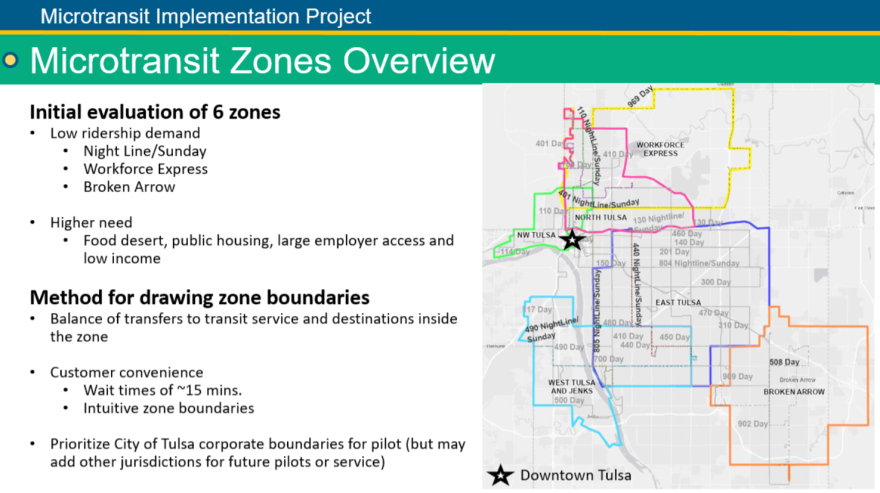Tulsa Transit is looking for feedback as it plans a new service: microtransit.
Picture Uber or Lyft, but run by a transit agency. Small vehicles would offer on-demand rides within set zones, scheduled via a smartphone app or phone call.
“Generally, you can expect that your ride will either be a solo ride or a small carpool of one to a few passengers. Generally, we aim to design the service to have a wait time between a passenger request and when they're actually picked up of about 15 to 20 minutes,” said Allison Buchwach with HNTB, a consulting firm that works with Tulsa Transit.
Tulsa Transit is looking for public input on six proposed zones with low fixed-route ridership — two to four passengers per hour on average — over the next several weeks. Microtransit will be tested in one or two zones. The service would replace the more costly buses, but additional funding won’t be budgeted for the new service.
“It's kind of like when we did our redesign on our complete service. Everything was cost neutral. So, we just kind of took the budget that we had and readjusted to provide a better service on the street,” said Tulsa Transit Planning and Marketing Director Liann Alfaro.
A northwest Tulsa zone has boundaries stretching from 65th West Avenue to Peoria Avenue west to east and from 11th Street to Apache Street north to south. It largely skirts the Inner Dispersal Loop and stays west of U.S. 75. Night Line route 110 would be replaced there.
A north Tulsa zone is generally bounded by I-244 to the south, Highway 11 and U.S. 75 on the west, 56th Street North to the north, and Tisdale Parkway to the east. Night Line routes 110 and 401 would be replaced there.
An east Tulsa zone is the most expansive and would likely need to be broken up into two zones if it is selected. The proposed boundaries are generally I-244 to 81st Street north to south and Peoria Avenue to 145th East Avenue west to east. Night Line routes 440 and revised 490 would be replaced there.
A west Tulsa and Jenks zone goes as far west as 41st West Avenue, but most of its western boundary is along 33rd West Avenue. It goes as far east as Memorial Drive. East of the Arkansas River, the southern boundary is 81st Street, and the northern boundary is 51st Street. West of the river, the zone extends south of the Creek Turnpike and north to 36th Street. Night Line route 490 would be replaced there.
Another zone encompasses an area around Tulsa Transit’s recently launched Workforce Express Network Route 969, which connects north Tulsa to employers in the U.S. 169 corridor. That shuttle, which has seen a maximum of 16 riders in a day since October 2020, would be replaced there.
The sixth zone would cover the area currently served by Route 508, a circulator serving Broken Arrow, and replace that service.
While the six potential zones cover all of Tulsa and parts of Broken Arrow and Jenks, the current plan for most of them is for microtransit riders to be delivered to bus rapid transit stations existing on the Peoria Avenue Aero line or planned for the forthcoming Route 66 line.
“Those routes are really the backbones of the Tulsa Transit network, based on how much frequency that those two services will have. So, we expect that to have a lot of draw in the region and, therefore, we want to make sure these microtransit zones are serving quality fixed-route services,” Buchwach said.
Feedback on the zones can be submitted online at tiny.cc/microtransit_feedback.




